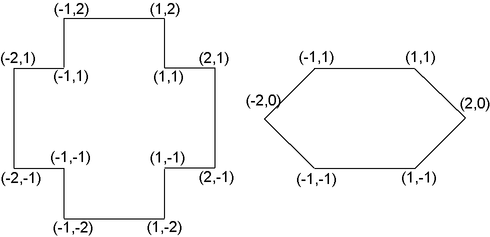
Zadanie Osie symetrii (osi)
Pomóż nam usprawnić bazę zadań!
Axes of Symmetry
Memory limit: 32 MB
Little Johnny - a well-respected young mathematician - has a younger sister, Justina. Johnny likes his sister very much and he gladly helps her with her homework, but, like most scientific minds, he does mind solving the same problems again. Unfortunately, Justina is a very diligent pupil, and so she asks Johnny to review her assignments many times, for sake of certainty. One sunny Friday, just before the famous Long May Weekend1 the math teacher gave many exercises consisting in finding the axes of symmetry of various geometric figures. Justina is most likely to spend considerable amount of time solving these tasks. Little Johnny had arranged himself a trip to the seaside long time before, nevertheless he feels obliged to help his little sister. Soon, he has found a solution - it would be best to write a programme that would ease checking Justina's solutions. Since Johnny is a mathematician, not a computer scientist, and you are his best friend, it falls to you to write it.
Task
Write a programme that:
- reads the descriptions of the polygons from the standard input,
- determines the number of axes of symmetry for each one of them,
- writes the result to the standard output.
Input
In the first line of the input there is one integer  (
( ) -
it is the number of polygons, for which the
number of axes of symmetry is to be determined. Next,
) -
it is the number of polygons, for which the
number of axes of symmetry is to be determined. Next,  descriptions of the polygons follow. The first line of
each description contains one integer
descriptions of the polygons follow. The first line of
each description contains one integer  (
( ) denoting the number of vertices of the polygon. In
each of the following
) denoting the number of vertices of the polygon. In
each of the following  lines there are two integers
lines there are two integers  and
and  (
( ) representing
the coordinates of subsequent vertices of the polygon. The polygons need not be convex, but they have no
self-intersections - any two sides have at most one common point - their common endpoint, if they actually
share it. Furthermore, no pair of consecutive sides is parallel.
) representing
the coordinates of subsequent vertices of the polygon. The polygons need not be convex, but they have no
self-intersections - any two sides have at most one common point - their common endpoint, if they actually
share it. Furthermore, no pair of consecutive sides is parallel.
Output
Your programme should output exactly  lines, with the
lines, with the  'th line containing a sole integer
'th line containing a sole integer  - the number of axes of symmetry of the
- the number of axes of symmetry of the  'th polygon.
'th polygon.
Example
For the input data:
2 12 1 -1 2 -1 2 1 1 1 1 2 -1 2 -1 1 -2 1 -2 -1 -1 -1 -1 -2 1 -2 6 -1 1 -2 0 -1 -1 1 -1 2 0 1 1
the correct result is:
4 2

1. In Poland, there is an accumulation of public and national holidays in the beginning of May. Those are: 1st May - May Day, the International Workers' Day, 2nd May - the Day of the Polish Flag, 3rd May - the Anniversary of Establishment of the First Constitution of Poland (dating back to the year 1795); Though the middle, quite recent, feast is not actually a holiday, it is, however, customary to make it a day out of work too. Now imagine that 1st May is on Monday or 3rd May on Friday and you will get the feeling what the Long May Weekend is!
Task author: Piotr Stanczyk.
Kontakt
In the event of technical difficulties with Szkopuł, please contact us via email at [email protected].
If you would like to talk about tasks, solutions or technical problems, please visit our Discord servers. They are moderated by the community, but members of the support team are also active there.

 English
English